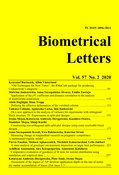
Biometrical Letters Vol. 57(2), 2020, pp. 131-150


The Cobb angle is calculated in the coronal plane, irrespective of vertebral rotation, lordokyphosis and local wedge properties of individual vertebrae other than the end plates used for the measurement. Rigorous threedimensional generalizations of the Cobb angle are complicated for at least two reasons. Firstly, the vertebral column is segmented, not continuous, making the choice of rigorous model ambiguous. Secondly, there exists an inherent curvature (in terms of thoracic kyphosis and lumbar lordosis) that may be considered physiologically healthy or ’normal’. When attempting to find a three-dimensional deviation measure, such normal sagittal curvature must be compensated for. In this paper we introduce a three-dimensional local deformation parameter (which we call the local effective deformation) motivated by both biomechanics and the basic theory of spatial curves, and simultaneously introduce a technical procedure to estimate the parameter from CT scans using MPR (multi-phase reconstruction) in PACS (IDS-7). A detailed description of the proposed modelling of vertebral column deformation is given, together with a stepwise procedure to estimate the three-dimensional deformation (in terms of local effective deformation). As a deformation measure it requires knowledge about the natural healthy kypholordosis. A method is described by which such knowledge may be incorporated in future work.

Scoliosis, Three-dimensional deformation, Cobb angle, Space curve

